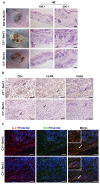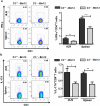Complement component 3 deficiency prolongs MHC-II disparate skin allograft survival by increasing the CD4(+) CD25(+) regulatory T cells population
- PMID: 27641978
- PMCID: PMC5027598
- DOI: 10.1038/srep33489
Complement component 3 deficiency prolongs MHC-II disparate skin allograft survival by increasing the CD4(+) CD25(+) regulatory T cells population
Abstract
Recent reports suggest that complement system contributes to allograft rejection. However, its underlying mechanism is poorly understood. Herein, we investigate the role of complement component 3 (C3) in a single MHC-II molecule mismatched murine model of allograft rejection using C3 deficient mice (C3(-/-)) as skin graft donors or recipients. Compared with C3(+/+) B6 allografts, C3(-/-) B6 grafts dramatically prolonged survival in MHC-II molecule mismatched H-2(bm12) B6 recipients, indicating that C3 plays a critical role in allograft rejection. Compared with C3(+/+) allografts, both Th17 cell infiltration and Th1/Th17 associated cytokine mRNA levels were clearly reduced in C3(-/-) allografts. Moreover, C3(-/-) allografts caused attenuated Th1/Th17 responses, but increased CD4(+)CD25(+)Foxp3(+) regulatory T (Treg) cell expression markedly in local intragraft and H-2(bm12) recipients. Depletion of Treg cells by anti-CD25 monoclonal antibody (mAb) negated the survival advantages conferred by C3 deficiency. Our results indicate for the first time that C3 deficiency can prolong MHC-II molecule mismatched skin allograft survival, which is further confirmed to be associated with increased CD4(+) CD25(+) Treg cell population expansion and attenuated Th1/Th17 response.
Figures







Similar articles
-
Critical influence of natural regulatory CD25+ T cells on the fate of allografts in the absence of immunosuppression.Transplantation. 2005 Mar 27;79(6):648-54. doi: 10.1097/01.tp.0000155179.61445.78. Transplantation. 2005. PMID: 15785370
-
IL-17A and IL-2-expanded regulatory T cells cooperate to inhibit Th1-mediated rejection of MHC II disparate skin grafts.PLoS One. 2013 Oct 11;8(10):e76040. doi: 10.1371/journal.pone.0076040. eCollection 2013. PLoS One. 2013. PMID: 24146810 Free PMC article.
-
Blimp-1 prolongs allograft survival without regimen via influencing T cell development in favor of regulatory T cells while suppressing Th1.Mol Immunol. 2018 Jul;99:53-65. doi: 10.1016/j.molimm.2018.04.004. Epub 2018 Apr 23. Mol Immunol. 2018. PMID: 29698799
-
Exogenous interleukin-33 targets myeloid-derived suppressor cells and generates periphery-induced Foxp3⁺ regulatory T cells in skin-transplanted mice.Immunology. 2015 Sep;146(1):81-8. doi: 10.1111/imm.12483. Epub 2015 Jun 19. Immunology. 2015. PMID: 25988395 Free PMC article.
-
Effects of complement activation on allograft injury.Curr Opin Organ Transplant. 2015 Aug;20(4):468-75. doi: 10.1097/MOT.0000000000000216. Curr Opin Organ Transplant. 2015. PMID: 26132735 Free PMC article. Review.
Cited by
-
Complement in Kidney Transplantation.Front Med (Lausanne). 2017 May 30;4:66. doi: 10.3389/fmed.2017.00066. eCollection 2017. Front Med (Lausanne). 2017. PMID: 28611987 Free PMC article. Review.
-
Complement C3 deficient mice show more severe imiquimod-induced psoriasiform dermatitis than wild-type mice regardless of the commensal microbiota.Exp Anim. 2024 Oct 23;73(4):458-467. doi: 10.1538/expanim.24-0043. Epub 2024 Jun 29. Exp Anim. 2024. PMID: 38945882 Free PMC article.
-
Landscape of infiltrating immune cells and related genes in diabetic kidney disease.Clin Exp Nephrol. 2024 Mar;28(3):181-191. doi: 10.1007/s10157-023-02422-1. Epub 2023 Oct 26. Clin Exp Nephrol. 2024. PMID: 37882850
References
-
- Walport M. J. Complement. First of two parts. The New England journal of medicine 344, 1058–1066 (2001). - PubMed
-
- Kemper C. & Atkinson J. P. T-cell regulation: with complements from innate immunity. Nature reviews. Immunology 7, 9–18 (2007). - PubMed
-
- Carroll M. C. The complement system in regulation of adaptive immunity. Nature immunology 5, 981–986 (2004). - PubMed
Publication types
MeSH terms
Substances
LinkOut - more resources
Full Text Sources
Other Literature Sources
Research Materials
Miscellaneous

